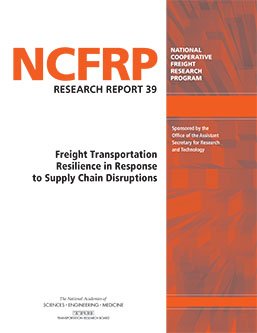|
|

 Impacts of Policy-Induced Freight Modal Shifts
12/17/2019 7:02:25 AM
Impacts of Policy-Induced Freight Modal Shifts
12/17/2019 7:02:25 AM
In recent public policy debates, much emphasis has been placed on proposals to shift freight from highways to rail. This emphasis is based on goals of reducing emissions and highway congestion. However, prudent planning requires an understanding of the basics of mode choices, what could change those choices, and what the impacts will be. The TRB National Cooperative Freight Research Program's NCFRP Research Report 40: Impacts of Policy-Induced Freight Modal Shifts provides public policymakers with the fa...
 Freight Transportation Resilience in Response to Supply Chain Disruptions
9/23/2019 5:00:53 PM
Freight Transportation Resilience in Response to Supply Chain Disruptions
9/23/2019 5:00:53 PM
Guidance to public and private stakeholders on mitigating and adapting to logistical disruptions to supply chains resulting from regional, multi-regional, and national adverse events, both unanticipated and anticipated, is provided in NCFRP (National Cooperative Freight Research Program) Research Report 39: Freight Transportation Resilience in Response to Supply Chain Disruptions . The report makes a significant contribution to the body of knowledge on freight transportation and system resiliency ...
 Guide for Conducting Benefit-Cost Analyses of Multimodal, Multijurisdictional Freight Corridor Investments
4/6/2017 6:20:35 PM
Guide for Conducting Benefit-Cost Analyses of Multimodal, Multijurisdictional Freight Corridor Investments
4/6/2017 6:20:35 PM
TRB's National Cooperative Freight Research Program (NCFRP) Research Report 38: Guide for Conducting Benefit-Cost Analyses of Multimodal, Multijurisdictional Freight Corridor Investments explores how to conduct benefit-cost analyses (BCAs). A BCA is an analytical framework used to evaluate public investment decisions including transportation investments. BCA is defined as a collection of methods and rules for assessing the social costs and benefits of alternative public policies. It promotes efficiency b...
 Enhancing Sleep Efficiency on Vessels in the Tug/Towboat/Barge Industry
1/25/2016 12:00:45 PM
Enhancing Sleep Efficiency on Vessels in the Tug/Towboat/Barge Industry
1/25/2016 12:00:45 PM
TRB's National Cooperative Freight Research Program (NCFRP) Report 36: Enhancing Sleep Efficiency on Vessels in the Tug/Towboat/Barge Industry provides best practices to improve an operator's sleep and reduce operator fatigue in the United States inland waterway industry, including the use of anchor-sleep/nap-sleep strategies. NCFRP Report 36 identifies and describes the metrics that could be used to evaluate current operational interventions (e.g., educational materials and programs; noise abatement; sl...
 Implementing the Freight Transportation Data Architecture: Data Element Dictionary
8/24/2015 1:32:06 PM
Implementing the Freight Transportation Data Architecture: Data Element Dictionary
8/24/2015 1:32:06 PM
TRB's National Cooperative Highway Research Program (NCFRP) Report 35: Implementing the Freight Transportation Data Architecture: Data Element Dictionary provides the findings of the research effort to develop a freight data dictionary for organizing the myriad freight data elements currently in use. A product of this research effort is a web-based freight data element dictionary hosted by the U.S. Department of Transportation’s Bureau of Transportation Statistics (BTS). The project web page includes a l...
 Improving Freight System Performance in Metropolitan Areas: A Planning Guide
4/22/2015 11:00:02 AM
Improving Freight System Performance in Metropolitan Areas: A Planning Guide
4/22/2015 11:00:02 AM
TRB’s National Cooperative Freight Research Program (NCFRP) Report 33: Improving Freight System Performance in Metropolitan Areas: A Planning Guide outlines potential strategies and practical solutions for public and private stakeholders to improve freight movement system performance in diverse metropolitan areas. The report includes links to an Initiative Selector tool to aid in the selection of possible alternatives for various problems, and Freight Trip Generation (FTG) software that planners can use ...
 Incorporating Truck Analysis into the Highway Capacity Manual
9/8/2014 6:52:42 AM
Incorporating Truck Analysis into the Highway Capacity Manual
9/8/2014 6:52:42 AM
TRB’s National Cooperative Freight Research Program (NCFRP) Report 31: Incorporating Truck Analysis into the Highway Capacity Manual presents capacity and level-of-service techniques to improve transportation agencies’ abilities to plan, design, manage, and operate streets and highways to serve trucks. The techniques also assist agencies’ ability to evaluate the effects of trucks on other modes of transportation. These techniques are being incorporated into the Highway Capacity Manual , but will be usefu...
|
|